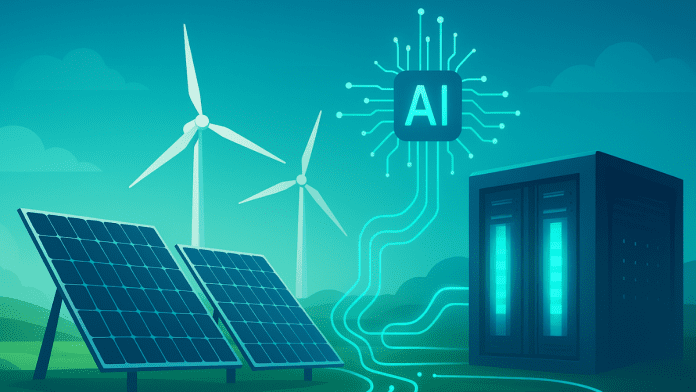🕒 Last updated on November 3, 2025
The iShares Global Clean Energy ETF (ICLN) has become one of the most closely followed investment funds in global markets. It invests in nearly one hundred companies focused on renewable energy, including solar, wind, and energy storage. Over the past year, the ETF has gained more than 50 percent, showing strong investor confidence in the clean energy transition.
This growth is closely tied to the boom in artificial intelligence. AI technology depends on large data centers that run constantly and use massive amounts of power. As demand for these facilities rises, clean energy sources like solar and wind are becoming essential to meet electricity needs without increasing carbon emissions.
AI’s expansion has created new opportunities for renewable power producers. Solar panels, wind farms, and battery storage systems are being built at record pace to support the data-driven economy. For investors, this has made ICLN a symbol of how technology and sustainability can work together.
However, the sector now faces serious policy uncertainty. In the United States, political debates could reshape the future of renewable incentives. The discussion centers on the Inflation Reduction Act, a 2022 law that provides tax credits and subsidies for clean energy development. These incentives have been key to the growth of renewable projects, but proposed policy changes could weaken them at a critical time.
Green energy gets a brain — Infosys’ AI transforms wind and solar into unstoppable power sources
Political Shifts Create Market Uncertainty
The Inflation Reduction Act helped drive billions of dollars of new investment into clean energy. It encouraged companies to expand production and build long-term projects. Yet in 2025, with new leadership in Washington, there are proposals to roll back or reduce these benefits.
Some lawmakers are considering shortening the duration of clean energy tax credits or phasing them out earlier than expected. Such changes could affect the financial stability of solar and wind projects that depend on predictable subsidies. Industry analysts warn that these moves could disrupt project planning and make investors more cautious.
This political tension comes as global energy needs reach record highs. The surge in AI-driven electricity demand means that renewable energy companies must scale quickly to meet demand. Without consistent policy support, they could struggle to do so efficiently.
The iShares Global Clean Energy ETF (ICLN) has shown resilience despite these challenges, but market data indicates growing caution among investors. Clean energy developers rely on stable regulations to finance and complete multi-year projects. Any shift in incentives could impact returns and slow the industry’s momentum.
Analysts describe the situation as a balancing act — strong technological demand on one side and political uncertainty on the other. That combination has made the clean energy sector one of the most closely monitored areas of the market in 2025.
Solar energy goes supernova — prices crash, China dominates, and the U.S. hesitates
Solar Strength vs. Wind Struggles
Inside the ETF, company results reveal a clear divide between solar and wind power.
First Solar, one of the ETF’s top holdings, reported record quarterly sales of 5.3 gigawatts of panels and earnings per share of $4.24. Its revenue and margins were strong, reflecting high demand for solar installations. However, the company issued cautious forward guidance, signaling that potential policy changes could affect future growth.
Enphase Energy also delivered solid earnings and revenue, driven by demand for its solar inverters and smart energy systems. Still, the company shared a careful outlook, highlighting broader market uncertainty.
The wind sector has faced greater difficulty. Vestas, a major turbine manufacturer, reported higher revenue but lower order intake, particularly in the U.S. market. The slowdown was linked to uncertainty about future policy support. Danish offshore wind developer Ørsted cut its full-year forecast after weaker wind speeds reduced power generation.
This contrast shows how uneven the renewable landscape has become. Solar continues to perform strongly thanks to steady demand and declining costs, while wind firms are facing operational challenges and policy-related pressures.
As investors watch these developments, the iShares Global Clean Energy ETF (ICLN) stands at a crossroads — driven by the world’s need for clean electricity but challenged by political headwinds that could reshape its path forward.

